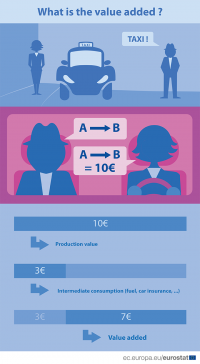Beginners:GDP - Calculating GDP
Highlights
This article is part of Statistics 4 beginners, a section in Statistics Explained where statistical indicators and concepts are explained in a simple way to make the world of statistics a bit easier for pupils and students as well as for everyone else with an interest in statistics.
What is the basis for the calculation of GDP?
GDP is a key measure within a wider framework of economic statistics which is often simply referred to as national accounts. The European system of national and regional accounts (ESA) defines the binding standards and methods used for compiling these accounts, whereas the global standard set by the United Nations (UN) is called the System of National Accounts (SNA). These standards are updated regularly to reflect changes in the economy, such as technological or financial developments. The latest version from the UN is from 2008 (SNA 2008), while the latest version from the EU is from 2010 (ESA 2010). More information can be found on the Eurostat website on the page dedicated to ESA 2010.
GDP does not come from a single survey. In fact, national accounts are compiled by pulling together data from a vast range of sources including sample surveys of businesses and households as well as administrative data such as VAT declarations (value added tax - a tax on the value that has been added to products and services). More information on the data sources is provided in a separate article.
Full article
How is GDP calculated?
GDP can be calculated in different ways, but the most common is the production approach. To understand the production approach, it is essential to understand what value added and basic prices are.
Box 1: What is value added?
The value added of production is the extra value that has been created from the making of good and services. In simple terms, it is the value of goods and services produced minus the value of materials and other goods and services consumed in the production process (known as intermediate consumption).
Example: Leonie is a taxi driver and charges a customer € 10 for a trip and that is the value of her service. In order for Leonie to provide this service she must pay for petrol, car insurance and a number of smaller items which all together for this trip cost her € 3; this is her intermediate consumption.
Her value added for this trip is the production or service value minus the cost of the intermediate consumption: € 10 - € 3 = € 7.
Box 2: What are basic prices?
The actual price of good and services that balances needs from the seller and the buyer is the market price. However, in national accounts, other prices can be used depending upon how taxes (money that people or businesses have to pay the government) and subsidies (money paid by a government to help or encourage businesses) on products are recorded.
Thus, the basic price is the amount of money actually received and kept by the producer. It excludes all taxes on the final products, but includes any subsidies the producer receives from the state as an encouragement to lower the prices.
In conclusion, to calculate GDP, the production approach adds up the value added at basic prices of all industries. To this are then added taxes on goods or services, while subsidies on goods or services are subtracted, in order to obtain GDP at market prices.
As already mentioned, there is not a single way to calculate GDP. In fact, there are other two methods to obtain the value for GDP: the "expenditure" and the "income" approach. However, the three approaches should all lead to the same result.
How often is GDP calculated?
In the EU, GDP is calculated for different reference periods. Generally, it is commonly referred to as annual GDP, but it is also calculated every three months, called quarterly GDP. Some EU Member States calculate or plan to calculate monthly GDP.
Direct access to
Related articles in Statistics 4 beginners:
Related articles in Statistics Explained:
- All Statistics Explained articles on national accounts and GDP
- National accounts and GDP
- National accounts background
- National accounts — an overview
Glossary items in Statistics Explained:
- Gross domestic product (GDP)
- European Union (EU)
- National and regional accounts
- European system of national and regional accounts
- United Nations (UN)
- System of national accounts (SNA)
- Value added
- Research and development (R&D) intensity
- Intermediate consumption
- Basic prices
- Taxes
- Subsidies
- Borrow/lend
- Public debt
- Government deficit
- Brochure To understand economic growth INSEE France
- Visualisation GDP and me ONS United Kingdom
- Video GDP INE Spain
- Video National Accounts Statistics Finland

